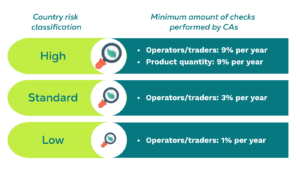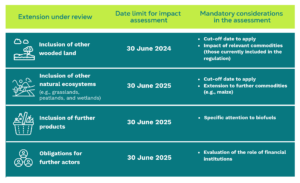The EU Deforestation Regulation is Entering Into Force: The Final Outlook

Article drafted by Rita Raleira, Researcher, Deforestation-free Supply Chains
It is official now – the EU Deforestation Regulation (EUDR), published in the Official Journal of the European Union on 9 June 2023, will officially enter into force on 29 June 2023. Its core obligations, however, will only become applicable as of 30 December 2024, giving companies and EU Member States an 18-month period to implement the requirements and adequately prepare its enforcement. This will be key to minimize the EU’s contribution to deforestation and forest degradation, greenhouse gas emissions, and biodiversity loss – the goals this regulation has set out to achieve.
About one year after the initial proposal by the European Commission was published – and after several rounds of amendments and negotiations -, EU decision-makers landed on a final text, endorsed by both the European Parliament and the Council of the EU in April and May 2023 respectively. With an arduous period of implementation lying ahead, it is time to look at the main elements and requirements of this pioneering regulation.
PRODUCTS COVERED.
The EUDR will kickstart with seven commodity groups – cattle (beef and leather), cocoa, coffee, palm oil, rubber, soy, and wood –, representing the largest share of deforestation driven by EU consumption. Besides for these commodity groups, more than 70 relevant products, listed in Annex I of the regulation, will be covered and must comply with the requirements established.
MAIN REQUIREMENTS: PROHIBITIONS AND OBLIGATIONS OF OPERATORS AND TRADERS
The commodities and products covered by the EUDR will be required to meet three criteria without which they cannot be placed in or exported from the EU market. These criteria are:
- Being deforestation-free: The plot(s) of land of production must not have been subjected to deforestation or forest degradation after 31 December 2020 (known as the cut-off date).
- Being legally produced: The products must have been produced in accordance with the relevant legislation of the country of production concerning, for instance, the legal status of the land of production (land use rights) and human rights protected under international law.
- Being covered by a due diligence statement: Operators will have to submit a statement (exemplified in Annex II of the regulation), prior to placing products in or exporting them from the EU market, through an information system developed for this purpose. This statement will include 1) information collected as part of the due diligence requirements (e.g., geolocation), and 2) a declaration stating that no risk (or only negligible risk) was found.
To ascertain these conditions, both operators and (non-SME) traders will have to exercise due diligence prior to placing in or exporting relevant products from the EU market. This will imply establishing a due diligence system, bound to annual revisions, which must include three compulsory elements:
Simplified due diligence, requiring only the information gathering, will also be possible under the EUDR. Operators and traders can be exempt from fulfilling the risk assessment and mitigation obligations when products originate from low-risk countries or parts thereof. However, if information arises indicating that these products are in fact facing risk of non-compliance with the requirements, operators/traders must assess and eventually mitigate the risk(s) found.
COUNTRY BENCHMARKING.
The overall structure of the three-tier system for the assessment of countries remains the same as proposed by the European Commission in 2021. Countries and parts thereof will be classified according to three levels of risk:
Upon the entering into force of the regulation, all countries will be assigned a standard level of risk. However, this might change by the time the European Commission publishes the list of low and high-risk countries, which must happen until the date of application of the regulation – 30 December 2024. The full list of countries and the risk category they have been assigned will be publicly available.
CONTROLS AND CHECKS: OBLIGATIONS OF EU MEMBER STATES AND COMPETENT AUTHORITIES.
EU Member States (MSs) must designate a Competent Authority (CA) responsible for the oversight of the EUDR obligations. The European Commission must be informed of this choice until 30 December 2023 and the full list of designated CAs must be publicly available online. To ensure that checks are effectively carried out and to harmonize the rules on enforcement (reducing the risk of forum shopping), CAs will have to meet minimum thresholds on the checks performed annually, which are based on the classification of risk of the country benchmarking. The amounts of checks stipulated in the regulation should be met for each of the relevant products separately and are based on the total number of operators that, in the previous year, placed the relevant product on the EU market or exported it from it (the same goes for product quantity where applicable).
CAs should also have the capacity to identify the checks that need to be carry out (including beyond the established minimum) whenever they obtain or are made aware of relevant information concerning a possible case of non-compliance. CAs should use a risk-based approach and analyze the likelihood of non-compliance on the basis of criteria such as complexity and length of the supply chains, stage of processing of the product, location of plots of land of production (and their proximity to forested areas), and history of non-compliance of the operators/traders potentially involved.
One of the means through which CAs can be made aware of cases of non-compliance is through the complaint mechanism foreseen by the regulation, where substantiated concerns can be submitted. If the substantiated concerns, constituting “duly reasoned claims based on objective and verifiable information regarding non-compliance with the Regulation”, are deemed suitable based on due assessment, CAs should take the necessary actions, including carrying additional checks, conducting hearings with the respective operators/traders, and even preventing the placing of the product on the EU market.
EXPECTED REVIEWS.
The scope of the EUDR is not set in stone. Other ecosystems and/or products may, in the future, also be covered by the regulation if (and when) such extension is deemed appropriate. Any eventual extension will require that an impact assessment is conducted, which may be followed by a dedicated legislative proposal if the findings of that assessment justify it. Several review moments, addressing possible scope extensions, are already foreseen in the regulation, all of which include deadlines for the presentation of the respective impact assessments and some specifications on elements that must be taken into consideration in the assessment conducted.
Besides these revision moments, the European Commission should carry out a general review of the EUDR every five years from the moment it enters into force. The first one should then take place until 30 June 2028, at which point a report shall be presented to the Council of the EU and the European Parliament and it must include, among other aspects, the impact the regulation has had thus far on smallholders, indigenous peoples and local communities.







